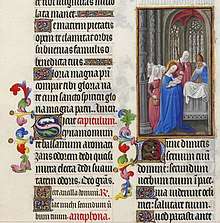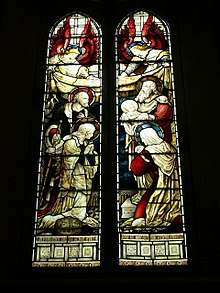Nunc dimittis
The Nunc dimittis[1] (/nʊŋk dɪˈmɪtɪs/); also known as the Song of Simeon or the Canticle of Simeon, is a canticle taken from the second chapter of the Gospel of Luke, verses 29 through 32. Its Latin name comes from its incipit, the opening words, of the Vulgate translation of the passage, meaning "Now you dismiss".[2] Since the 4th century it has been used in services of evening worship such as Compline, Vespers, and Evensong.[3]

Biblical account
The title is formed from the opening words in the Latin Vulgate, "Nunc dimittis servum tuum, Domine" ("Now thou dost dismiss thy servant, O Lord"). Although brief, the canticle abounds in Old Testament allusions. For example, "Because my eyes have seen thy salvation" alludes to Isaiah 52:10.[4]
According to the narrative in Luke 2:25-32, Simeon was a devout Jew who had been promised by the Holy Spirit that he would not die until he had seen the Messiah. When Mary and Joseph brought the baby Jesus to the Temple in Jerusalem for the ceremony of consecration of the firstborn son (after the time of Mary's purification: at least 40 days after the birth, and thus distinct from the circumcision), Simeon was there, and he took Jesus into his arms and uttered words rendered variously as follows:
Versions

The "Nunc dimittis" passage in the original Koiné Greek:
νῦν ἀπολύεις τὸν δοῦλόν σου, δέσποτα, κατὰ τὸ ῥῆμά σου ἐν εἰρήνῃ·
ὅτι εἶδον οἱ ὀφθαλμοί μου τὸ σωτήριόν σου,
ὃ ἡτοίμασας κατὰ πρόσωπον πάντων τῶν λαῶν,
φῶς εἰς αποκάλυψιν ἐθνῶν καὶ δόξαν λαοῦ σου Ἰσραήλ.
Transliterated:
Latin (Vulgate):
Nunc dimittis servum tuum, Domine, secundum verbum tuum in pace:
Quia viderunt oculi mei salutare tuum
Quod parasti ante faciem omnium populorum:
Lumen ad revelationem gentium, et gloriam plebis tuae Israel.
English (Translation of the Vulgate):
Now thou dost dismiss thy servant, O Lord, according to thy word in peace; Because my eyes have seen thy salvation, Which thou hast prepared before the face of all peoples: A light to the revelation of the Gentiles, and the glory of thy people Israel.
English (Book of Common Prayer, 1662):
Lord, now lettest thou thy servant depart in peace according to thy word.
For mine eyes have seen thy salvation,
Which thou hast prepared before the face of all people;
To be a light to lighten the Gentiles and to be the glory of thy people Israel.
English (Roman Breviary):
Now, Master, you let your servant go in peace. You have fulfilled your promise.
My own eyes have seen your salvation,
which you have prepared in the sight of all peoples.
A light to bring the Gentiles from darkness; the glory of your people Israel.
The King James Version (1611) contains the same text as the Book of Common Prayer, except for the last line (Luke 2:32), which simply reads "A light to lighten the Gentiles, and the glory of thy people Israel."
Church Slavonic (in Slavonic)[5]
Ны́не отпуща́еши раба́ Твоего́, Влады́ко, по глаго́лу Твоему́, съ ми́ромъ;
я́ко ви́деста о́чи мои́ спасе́нiе Твое́,
е́же еси́ угото́валъ предъ лице́мъ всехъ люде́й,
светъ во открове́нiе язы́ковъ, и сла́ву люде́й Твои́хъ Изра́иля.
Liturgy and musical settings

The Nunc Dimittis is the traditional 'Gospel Canticle' of Night Prayer (Compline), just as Benedictus and Magnificat are the traditional Gospel Canticles of Morning Prayer and Evening Prayer respectively.[4] Hence the Nunc Dimittis is found in the liturgical night office of many western denominations, including Evening Prayer (or Evensong) in the Anglican Book of Common Prayer of 1662, Compline (A Late Evening Service) in the Anglican Book of Common Prayer of 1928, and the Night Prayer service in the Anglican Common Worship, as well as both the Roman Catholic and Lutheran service of Compline. In eastern tradition the canticle is found in Eastern Orthodox Vespers. One of the most well-known settings in England is a plainchant theme of Thomas Tallis.
Heinrich Schütz wrote at least two settings, one in Musikalische Exequien (1636), the other in Symphoniae sacrae II (1647). The feast day Mariae Reinigung was observed in the Lutheran Church at J.S. Bach's time. He composed several cantatas for the occasion, including Mit Fried und Freud ich fahr dahin, BWV 125, a chorale cantata on Martin Luther's paraphrase of the canticle, and Ich habe genug, BWV 82.
In many Lutheran orders of service the Nunc Dimittis may be sung following the reception of the Eucharist.[6][7] A 1530 rhymed version by Johannes Anglicus, "Im Frieden dein, o Herre mein", with a melody by Wolfgang Dachstein, was written in Strasbourg for that purpose.[8]
Many composers have set the text to music, usually coupled in the Anglican church with the Magnificat, as both the Magnificat and the Nunc dimittis are sung (or said) during the Anglican service of Evening Prayer according to the Book of Common Prayer, 1662, in which the older offices of Vespers (Evening Prayer) and Compline (Night Prayer) were deliberately merged into one service, with both Gospel Canticles employed. In Common Worship, it is listed among "Canticles for Use at Funeral and Memorial Services"[9] Herbert Howells composed 20 settings of it, including Magnificat and Nunc dimittis (Gloucester) (1947) and Magnificat and Nunc dimittis for St Paul's Cathedral (1951). A setting of the Nunc dimittis by Charles Villiers Stanford was sung at the funeral of Margaret Thatcher as the recessional.[10] Stanford wrote many settings of both the Magnificat and Nunc dimittis.[11] Arvo Pärt composed a setting of the Nunc dimittis in 2001.
Sergei Rachmaninoff wrote a setting of the Slavonic Nunc dimittis text, Ны́не отпуща́еши (Nyne otpushchayeshi), as the fifth movement of his All-Night Vigil. It is known for its final measures, in which the basses sing a descending scale ending on the B♭ below the bass clef.[12]
Arvo Pärt set the Magnificat text from St Luke’s gospel in 1989 for choral forces in his home city, Berlin.[13][14]
Literary settings
- Thomas Jefferson, Letter to Marquis de Lafayette (17 May 1816), Joseph Cabell (31 January 1821), and General Andrew Jackson (18 December 1823)
- T. H. White novel The Once and Future King – recitation by Merlyn
- T. S. Eliot poem A Song for Simeon (1928)
- Joseph Brodsky poem "Nunc Dimittis" (1972)
- Ezra Pound poem "Cantico del Sole" (1918)
- Karel Čapek play R.U.R.
- Roald Dahl short story "Nunc Dimittis" (1953–1979)
- Tanith Lee story "Nunc Dimittis" (1984–1986)
- Walter Miller, A Canticle for Leibowitz
- John le Carré novel A Murder of Quality
- John le Carré novel Tinker Tailor Soldier Spy – closing theme of TV adaptation
- John le Carré novel The Constant Gardener – sung at the funeral of Tessa Quayle
- H. W. Brands novel The Strange Death of American Liberalism[15]
- David Mitchell novel Cloud Atlas – "Pacific journal of Adam Ewing, part 1"
- Edith Pargeter novel, writing as Ellis Peters in the 6th and 15th volumes of "The Cadfael Chronicles", The Virgin in the Ice and The Confession of Brother Haluin
References
- Machen, Minnie Gresham (1903). The Bible in Browning: With Particular Reference to The Ring and the Book. Macmillan. p. 157.
- "Nunc dimittis", Collins Dictionary
- "Nunc Dimittis". Encyclopedia Britannica.
-

- Sluzhebnik, Moscow Synodal Press 1896
- The Lutheran Service Book. Concordia Publishing House. 2005.
- Evangelical Lutheran Worship. Augsburg Fortress. 2006.
- Marti, Andreas (2011). "222 Im Frieden dein, oh Herre mein". In Herbst, Wolfgang; Alpermann, Ilsabe (eds.). Liederkunde zum Evangelischen Gesangbuch (in German). Vandenhoeck & Ruprecht. pp. 8–13. ISBN 978-3-64-750302-8.
- "The Church of England - Common Worship - Canticles for Use at Funeral and Memorial Services". Archived from the original on 29 September 2017.
- "Margaret Thatcher: the funeral Order of Service". Telegraph. 17 April 2013.
- Nunc dimittis, sung by the choir of King's College, Cambridge Archived 2014-11-29 at the Wayback Machine (1 Nov 2014)
- Warrack, John (2013-01-09). "Rachmaninov Vespers". www.gramophone.co.uk. Retrieved 2018-05-28.
- https://www.hyperion-records.co.uk/dw.asp?dc=W4350_GBAJY0337502. Missing or empty
|title=(help) - Nunc_dimittis_(Pärt)
- Brands, H. W. (2003). The Strange Death of American Liberalism. Yale University Press. ISBN 978-0-300-09824-2.
External links
| Wikimedia Commons has media related to Nunc dimittis. |
